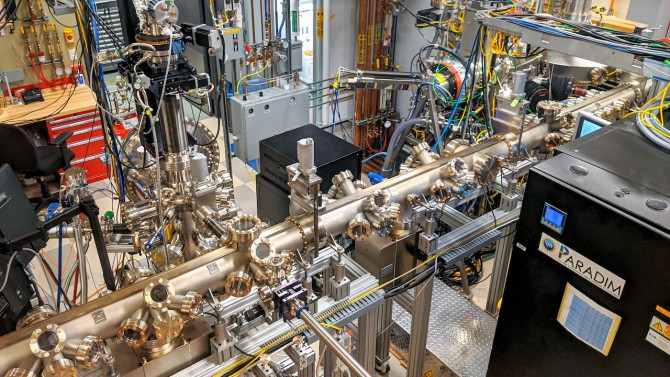Cornell's Platform for the Accelerated Realization, Analysis, and Discovery of Interface Materials (PARADIM) has received a second award of $22.5 million from the National Science Foundation (NSF) to fund another five years, enabling scientists, engineers and entrepreneurs nationwide to design and create new inorganic materials for use in electronics.
PARADIM, launched in 2016, is one of four material innovation platforms that emerged from the NSF's response to the National Materials Genome Initiative, which set out to discover, develop, manufacture and deploy advanced materials twice as quickly, and at a fraction of the cost, as conventional methods.
"PARADIM is creating a new model for materials research," said Charles Ying, the NSF program officer overseeing PARADIM. "Users throughout the country and scientists at Cornell University and Johns Hopkin University not only benefit from the state-of-the-art and often unique instruments, but also share technical know-how and data for a common goal of speedy design and creation of novel materials."
PARADIM enables scientists, engineers and entrepreneurs nationwide to design and create new inorganic materials for use in electronics.
In its first five years of operation, PARADIM has hosted more than 170 unique users from 41 universities and national labs, providing them with the state-of-the-art facilities, equipment and expertise to make breakthrough discoveries in electronic materials, which reverberate far beyond the lab.
"What's special to PARADIM is that it's not just a place where you send your ideas for new materials and we make them," said Lena Kourkoutis, associate professor in applied and engineering physics, and PARADIM co-director. "The users come to the facility and become part of the discovery process from idea to realization. They are being trained in approaches of making materials-by-design, and that has broader impact in the long run. We see this because we have a number of junior faculty who come to us, bring their students and jump-start their career."
Research at PARADIM has resulted in 140 journal publications to date. Among the platform's most notable discoveries are a new ultrawide bandgap semiconductor, rutile GeO2, in thin film form; a new type of topological insulator; and a form of galfenol that is the world's highest performance magnetostrictive material - a material consisting of tiny ferromagnets that can change its shape during magnetization - free of rare earth elements.
"The methods and collaborative environment that we make available to our users enable them to discover materials more quickly," said PARADIM co-director Darrell Schlom, the Herbert Fisk Johnson Professor of Industrial Chemistry in the Department of Materials Science and Engineering. "But it's not serendipitous discovery of better materials. It's what we would call materials-by-design. It's using the latest equipment and methods - to theorize, synthesize and characterize - in order to accelerate the discovery process."
PARADIM is also developing new tools and techniques, such as combining growth and characterization for interface materials. The platform helped a group led by David Muller, the Samuel B. Eckert Professor of Engineering, set a world record in 2018 for the highest resolution microscope, and recently topped that achievement by a factor of two by developing a next-generation electron microscope pixel array detector prototype.
"From its outset, PARADIM set itself the ambitious goal of creating an eco-system where any U.S. scientist can create and characterize virtually any inorganic electronic material of interest. The NSF renewal confirms that PARADIM has not just met this goal, but has in the process defined a world-class model for creating novel materials by design," said Lynden Archer, Joseph Silber Dean of Engineering.
In addition to being a national user facility, PARADIM is actively involved with fostering the next generation of materials scientists and technologists. Forty-seven students have participated in its Research Experiences for Undergraduates program, in which students work on projects supporting PARADIM's mission, and the platform offers a popular weeklong summer school program including lectures and hands-on learning, which has so far trained 230 people, many of whom returned as PARADIM users.
With the new NSF award, PARADIM will be offering two-year traineeships to seven incoming doctoral students in physics, applied physics and material science at Cornell and an additional four traineeships at Johns Hopkins University, which provides PARADIM's bulk-crystal growth facility.
PARADIM is also partnering with the Kavli Institute at Cornell for Nanoscale Science to initiate a new summer and sabbatical program to encourage greater diversity.
The funding renewal is allowing PARADIM to strategically invest in creating new capabilities in magnetic textures and quantum materials, which will help meet the growing interest for quantum technologies in storage and computation.
To that end, PARADIM has expanded its faculty team with the addition of Jie Shan, professor of applied and engineering physics in the College of Engineering and director of PARADIM's thin film facility, and Tomás Arias, professor of physics and a Stephen H. Weiss Presidential Fellow, director of PARADIM's theory user facility.
PARADIM is also investing in data, specifically artificial intelligence and machine learning, as a means to make and analyze samples faster. Data, after all, supports one of the key tenets of PARADIM: the open sharing of information and knowledge.
"The platform is free of charge to users from across the nation," Schlom said. "What the nation gets from it is the data. When users come and use the equipment, our equipment stores all of the synthesis conditions, the images of diffraction, whether it's electron diffraction, or X-ray diffraction. Normally if it's your own lab, only a small fraction of that data ever goes into a paper. And the rest of it is dark, it's lost. So part of our vision is to make all data, on successful as well as unsuccessful samples, available to the public. And that has some social aspects to it also."







